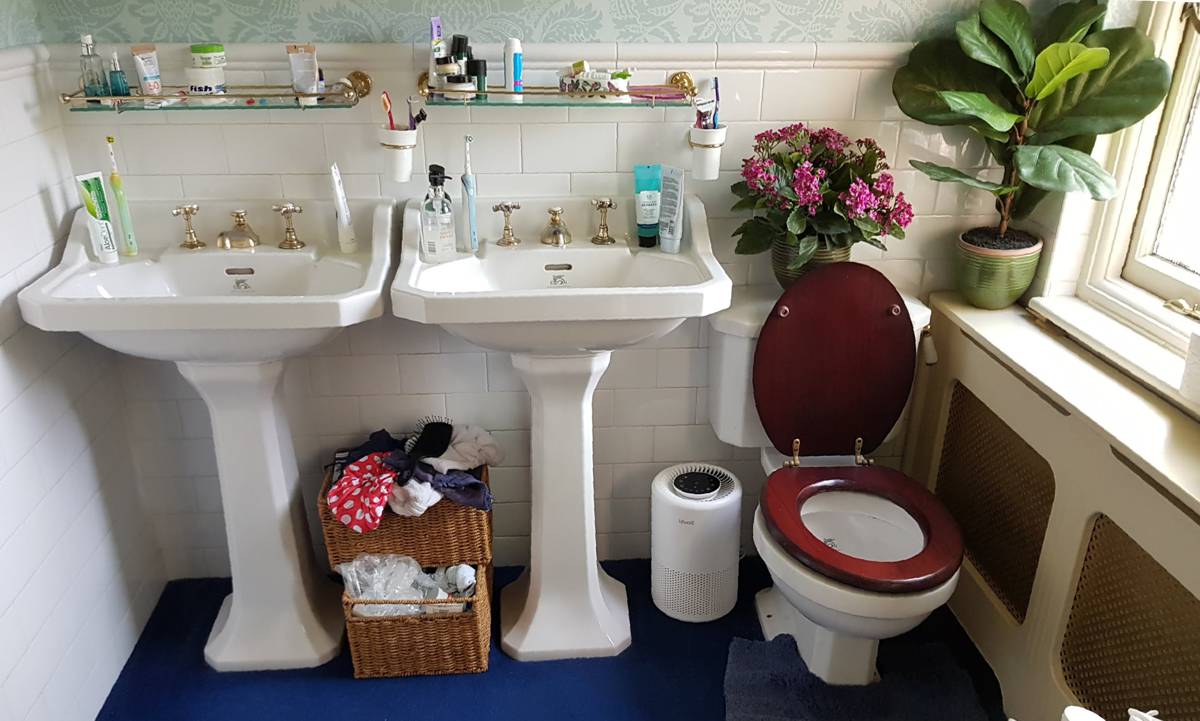A bathroom can be a room where odors are a problem. Fortunately, we can deal with these by using an air purifier. The type of air purification needed in the bathroom is rather different from that needed in the living room, kitchen, or bedroom. There needs to be more emphasis on removing chemicals from the air and less emphasis on removing particles.
The alternative of masking odors with an air freshener is less desirable simply removing the volatile organic chemicals causing the bathroom odor. This is because the air fresheners work by releasing a range of volatile organic compounds into the air, which bind to other pleasant smell receptors so masking the unpleasant smell. However, instead of using an air freshener, which introduces more chemicals into the air, many people prefer to use an air purifier to remove chemicals from their indoor air and provide clean air.
There are also constraints with space, bathrooms are usually fairly small rooms with not much free floor space. So it may not was be possible to use an ideal air purifier because there simply is not enough space. However fortunately, the small size of bathrooms means that most air purifiers, even some of the smaller ones, will be powerful enough to clean the air.
The iQair Multigas is the best bathroom air purifier as it provides the highest air quality. However, because of space or cost constraints, you may need a smaller air purifier.
I discuss the options below-
Reduction of Odors is the Main Aim-so chemical removal with carbon filters is most important
Odors are caused by volatile organic compounds (VOCs). To remove these compounds, we need an activated carbon filter. When the VOC molecule settles on the activated carbon, weak intermolecular bonds encourage the molecule to stay on the activated carbon. In this way VOC molecules are removed from the air.
So the larger the carbon filter, the better the air purifier will be at removing the volatile organic compounds, causing the odor from the air. Also, the more carbon there is in the filter, the longer it will last before it becomes saturated with VOCs and needs replacing.
Activated charcoal has lots of internal cracks and channels, which increase its surface area for absorbing VOCs tremendously, as shown in this diagram-
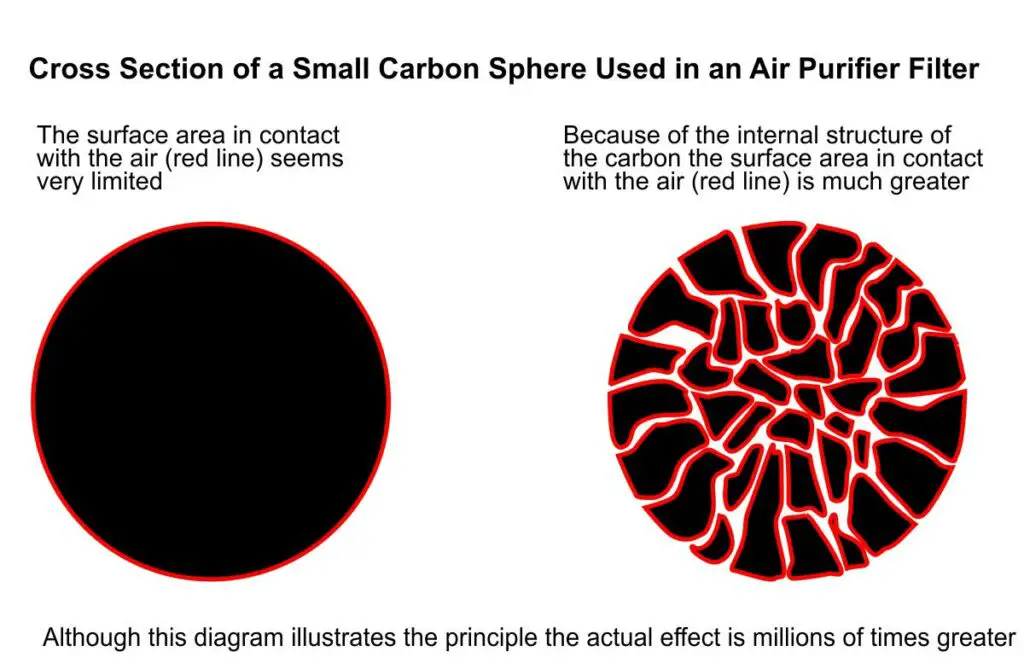
For instance, 1 gram of activated charcoal has an internal surface area of 32,000 square feet (3000m2). So although the filter in the illustration below is only approximately 1 sq ft, it has an equivalent surface area for absorbing gas, of 80 million sq ft!
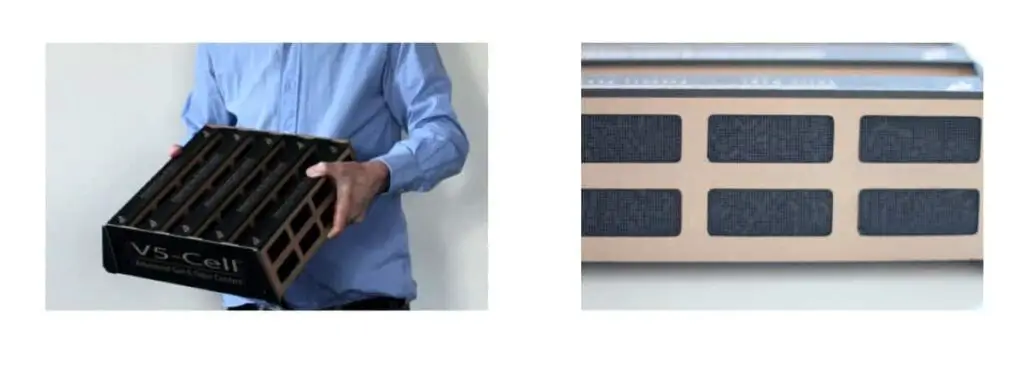
UV c light is not helpful in reducing a smell, as it does not break down volatile organic compounds.
The Reduction of Particles is Not so Important
Unless you are spending a few hours in the bathroom, the health benefits from airborne particle reduction will be small. Still you should buy a HEPA air purifier, and it should have a true HEPA air filter, not “HEPA like”, “HEPA Style”, “99% HEPA”…
So we do not need to be too obsessive about the type of HEPA air filter in the air purifier and we do not need to consider what size of nanoparticles a particular HEPA air filter will remove.
Humidity Will Interfere With Particle Filter Function
The humidity of the bathroom can be a factor in determining how well the air purifier works.
Once the humidity gets above 90% the efficiency of a true HEPA filter drastically declines.This is shown by the following diagram-
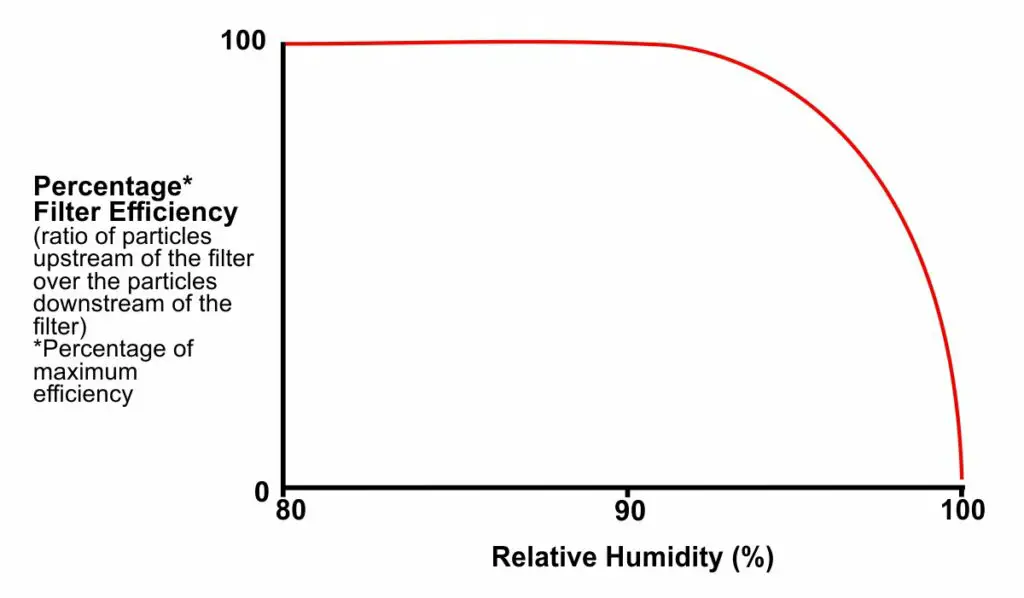
However, it is reassuring that for most of the range of humidity; the filter performs its function of reducing particles from the air very well. We just have to be careful to avoid very humid conditions.
Another potential problem with continual moisture on the HEPA filter is the possibility of fungi growing on the filter. The air stream through the filter would then take fungal spores and particles into the room air.
Humidity Can Also Interfere with the VOC (Odor) Filter
Also, when the humidity is high, water molecules attach themselves to the carbon filter. This makes it more difficult for the volatile organic compounds to become stuck to the activated carbon and decreases the effectiveness of the carbon filter.
Timing of Running the Air Purifier in the Bathroom
You will want to run the air purifier when people will likely use the bathroom. No doubt you will run it in the morning until people leave the home. Then probably run it again in the evening when people return from work/school/activities. You will also want it to cut off automatically late in the evening when everyone is sleeping.
So you will need a smart air purifier. This can be one connected to Wi-Fi and control by a smart phone. The alternative way of doing it is to have a very dumb air purifier connected to a smart plug. By very dumb I mean that when the on-off switch is on the minute electricity is connected the air purifier will come on. It can then be fully controlled by a smart plug.
Be very careful if you are going to use a smart plug that you do not buy one that when the electricity comes on you still need to press a button to activate the air purifier. This means that you cannot really control the “on” function with the smart plug, although you can turn it off with a smart plug.
1) iQair Multigas (supreme chemical filter specification and supreme particle filter)-overall best choice, space allowing
The air coming out of this air purifier will be better than any other air purifier on the market. It is specified to remove 99.5% of particles greater than 0.003um, the best particle specification on the market. Its removal of chemical compounds may well be the best on the market as well, there is only one other air purifier that comes close.
No pre-filter cleaning needed, this is quite an advantage as almost all other air purifiers have a type of pre-filter which should theoretically be cleaned every 2-4 weeks.
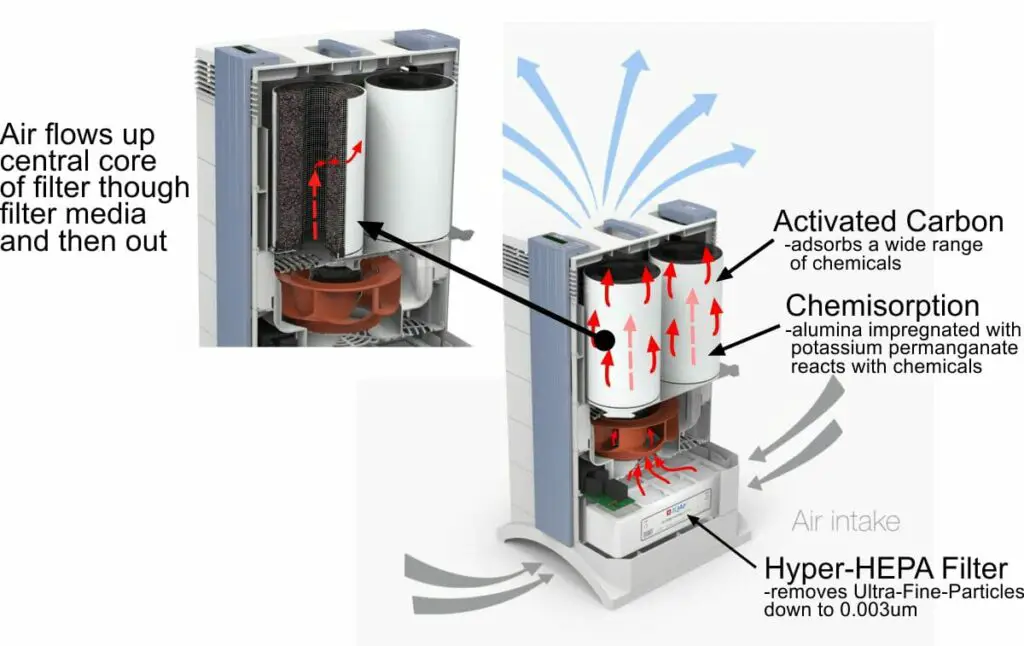
| Filters | |
| HEPA filter | HEPA specified to remove 99.8% of ultrafine particles down to a size of 0.003um |
| Carbon filter amount of carbon (lb) | 12 lb so so 100x more than some other air purifiers |
| Filter Change HEPA (Particles) | 12 months |
| Filter Change Carbon (Chemicals) | 29 months |
| Airflow | |
| CADR at =<50db (CADR on Maximum) | 170 cfm |
| Maximum Room Size (Noise less than 50db*) | 262 sq ft |
| Maximum Room Size (On noisiest setting) | 462 sq ft |
| Smart Control | Yes smart plug |
| Power | 74 W |
| Weight | 44 lbs |
| Dimensions “H x “W x D” | 28x 15 x 16 |
| Annual Running Cost Electricity ($) | $45 |
| Annual Running Cost Filters ($) | $285 |
| Total Annual Running Cost ($) | $330 |
All the above are approximate and assume running the air purifier for 12 hours per day on the highest setting that keeps the noise below the level specified in db in the table. This is less than or equal to 50db in normal daytime use and 35db for bedrooms.
*Most people will not wish to have the air purifier on a setting louder than about 35db for sleeping in a bedroom-you may wish to have a quieter setting than 35db this is just a ballpark estimate for most people. On the other hand, if your room layout allows you to be much further than 6 feet from the air purifier you may find the noise this machine makes at top speed is alright. The calculations for room size assume that you have 8 foot ceilings and 5 air changes per hour.
Never run an air purifier on auto mode using the inbuilt sensor. These cannot detect ultrafine particles which are damaging to human health, please see this article- How to test the air quality in your home.
2) Coway 400S-excellent, smaller size and cheaper price
This air purifier has a excellent filter, although with slightly lower specifications than the iQair. Its special feature is a high air flow together with the lowest possible noise levels for the airflow.
A good alternative would be the Coway 300S which is very similar but cheaper.
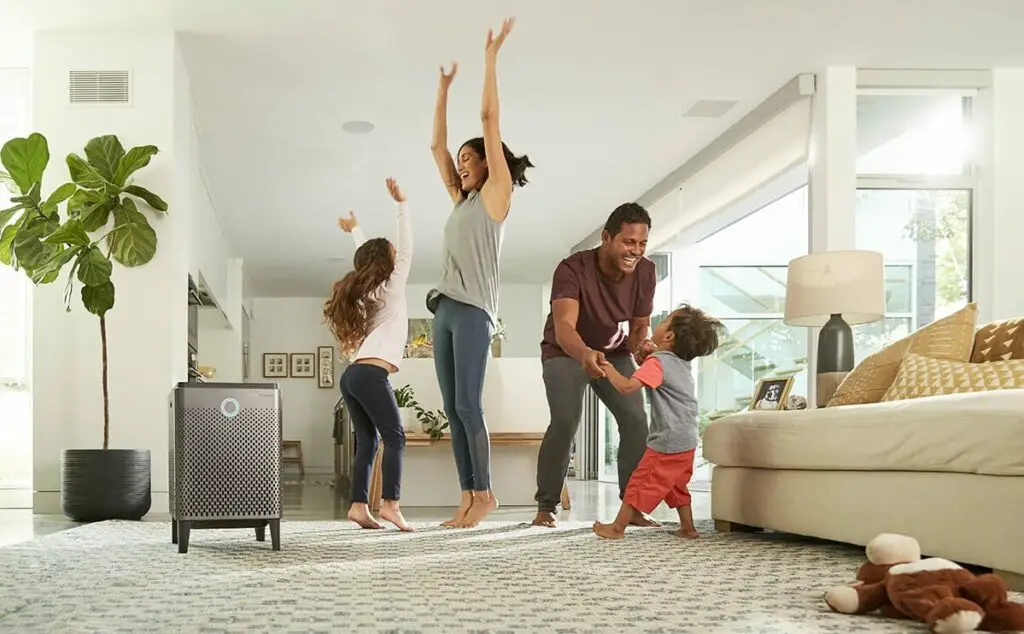
| Filters | |
| HEPA filter | HEPA specified to remove 99.8% of ultrafine particles down to a size of 0.01um |
| Carbon filter amount of carbon (lb) | 1.5 lb so more than most other air purifiers |
| Filter Change HEPA (Particles) | 12 months |
| Filter Change Carbon (Chemicals) | 12 months |
| Airflow | |
| CADR at =<50db (CADR on Maximum) | |
| Maximum Room Size (Noise less than 50db*) | 450 sq ft |
| Maximum Room Size (On noisiest setting) | 640 sq ft |
| Smart Control | Yes phone app |
| Power | 66 W |
| Weight | 24.7 lbs |
| Dimensions “H x “W x D” | 22.8 x 14.8 x 14.8 |
| Annual Running Cost Electricity ($) | $40 |
| Annual Running Cost Filters ($) | $120 |
| Total Annual Running Cost ($) | $160 |
3)Levoit 200S only $80-Most Cost Effective Option
This air purifier is stunningly good value for money. It is the cheapest air smart air purifier per unit air flow from a recognized US manufacturer.
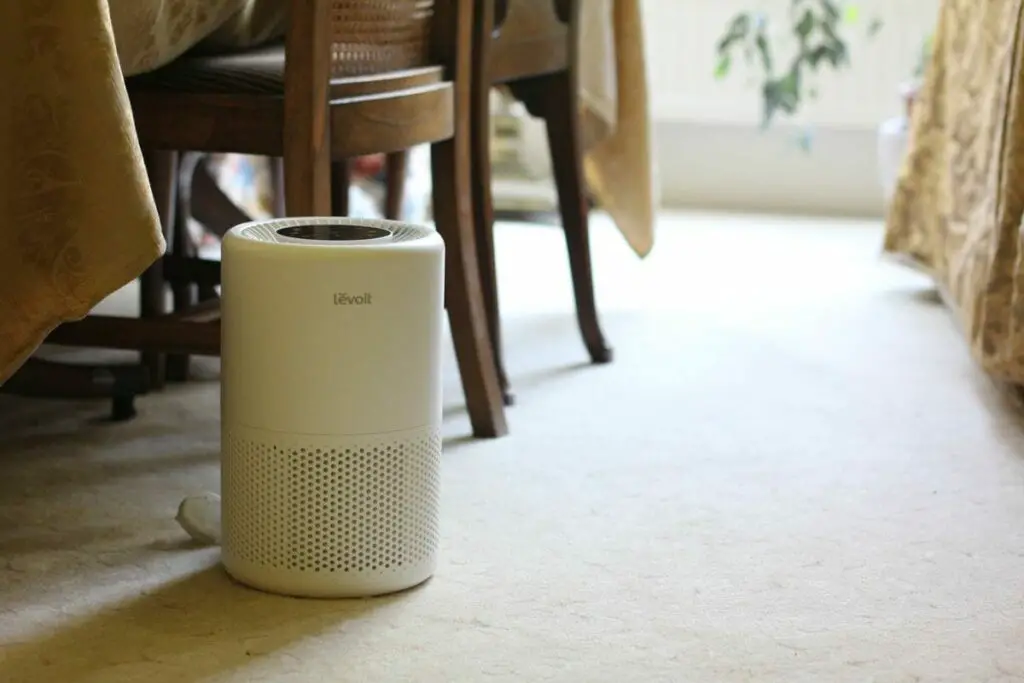
| Filters | |
| HEPA filter | HEPA |
| Carbon filter amount of carbon (lb) | Very small |
| Filter Change HEPA (Particles) | 6-8 months |
| Filter Change Carbon (Chemicals) | In same filter |
| Airflow | |
| CADR at =<50db (CADR on Maximum) | 118 cfm |
| Maximum Room Size (Noise less than 50db*) | 182 sq ft |
| Maximum Room Size (On noisiest setting) | 182 sq ft |
| Smart Control | Yes WiFi |
| Power | 37W |
| Weight | 6.6lbs |
| Dimensions “H x “W x D” | 8.1 x 8.1 x 12.6 |
| Annual Running Cost Electricity ($) | $22 |
| Annual Running Cost Filters ($) | $45 |
| Total Annual Running Cost ($) | $67 |
This is approximately 4 times as loud as the Coway 400S for a 200 sq ft room.
Other Measures
Of course, it is very important to deal with the source of any unpleasant odor.
The most obvious one is the toilet bowl. However, there may be other sources of the bad smell, such as mold growing in hidden places because of the humidity in the bathroom.
Will an Air Purifier Stop Mold Growth in a Bathroom?
An air purifier will not prevent mold in a bathroom. It will lower the spore count, however there are so many mold spores in the air that it will be impossible for the air purifier to remove them all. If a few spores settle on a damp wall or ceiling, they will germinate and mold will grow.
The best way to stop mold is to lower the relative humidity in the bathroom below 80%. At these levels of humidity, mold will not grow. So you may need a dehumidifier as well as an air purifier.
Conclusion-best bathroom air purifier
Any of the contenders above for the best bathroom air purifier should give you more fresh air and improve the indoor air quality in the bathroom. The filtration of volatile organic compounds is key in removing unpleasant odors. So the main criterium for choosing the best air purifier overall is the activated carbon filter. This makes the choice for best bathroom air purifier obvious in terms of air quality. It is the iQair Multigas.
However, it may be more practical for you to have a smaller or cheaper machine. The Coway 300 S is an excellent smaller machine. The cheapest and smallest of all is the Levoit 200S, but this also has the least carbon in the filter.

